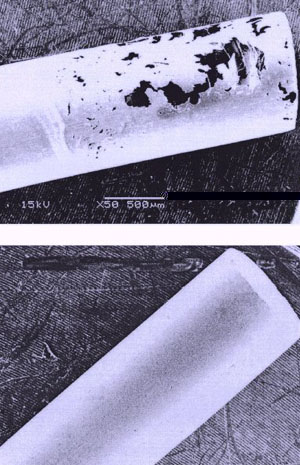Polymers in shampoo that leave your hair feeling silky smooth could also help prevent gas and oil leaks from pipelines by giving them an anti-corrosion coating.
Layering is the key to making polymers effective in protecting metals from corrosion, explains materials chemist Joseph Schlenoff of the Florida State University. He and chemistry graduate student Tarek Farhat recognised that the same polymers added to shampoos that leave a thin layer of either positively or negatively charged polymer on the hair could also be used to make a multilayer coating containing both positively and negatively charged high molecular weight polymer electrolytes. Such a skin would prevent corrosive salt ions from penetrating the layer and so would make a seal to rival traditional paints or resins, says Schlenoff.

Joseph Schlenoff
Salt and moisture catalyse the corrosive reactions of oxygen with metals and metal alloys. The presence of microscopic defects on the metal surface creates active sites where salt ions can sit and trigger these oxidizing reactions. To stop this happening a protective layer is needed that expels salt ions.
We start with a negatively charged metal surface and coat it with a positively charged liquid, or aqueous, polymer, then add a negatively charged aqueous polymer, and keep adding positive and then negative layers of polymers, Schlenoff says. A gel layer less than one micrometer thick is formed as the positive and negative layers bond to each other but the result is a net electrically neutral layer.

What a difference a coating will make to corrosion of a steel pipe
To corrosion protect a pipeline the researchers suggest that the aqueous polymers would be pumped through an installed pipeline one after the other, first the positive, then the negative. All the microscopic pits and faults on the inside wall of the pipe would be coated with the multilayer polymer.
Schlenoff points out that the process can be carried out on newly installed pipelines or temporarily decommissioned ones just as easily. The technique can protect stainless steel immersed in salt water from corrosion as well as aluminium. According to Schlenoff, it would be inexpensive in terms of materials costs as the polymer solutions could be re-used. The technique also avoids the use of toxic, volatile organic compounds as solvents.
The technique may have another connection with the bathroom in that since reporting their results, the FSU team has been contacted by a well-known manufacturer of disposable razors with a view to improving their stainless steel products. This technique can coat all metallic surfaces, including disposable razors, to prevent corrosive ions from reaching them and to provide a bit of lubrication, says Schlenoff. I don’t know the optimum polymer/pipeline combination, he told Spotlight, but the polymers we use most could be used to protect the insides of water-carrying lines, or the outsides of just about any kind of steel pipe.
Further reading
Electrochem. Solid State Lett. 2002, 5, B13
Joseph Schlenoff
http://www.chem.fsu.edu/bio.php?id=39
Suggested searches
Corrosion
Polyelectrolytes